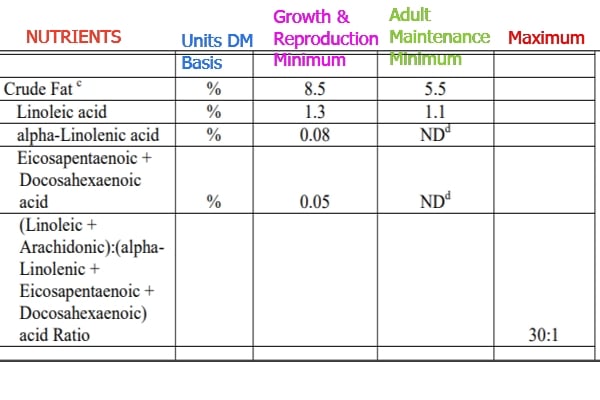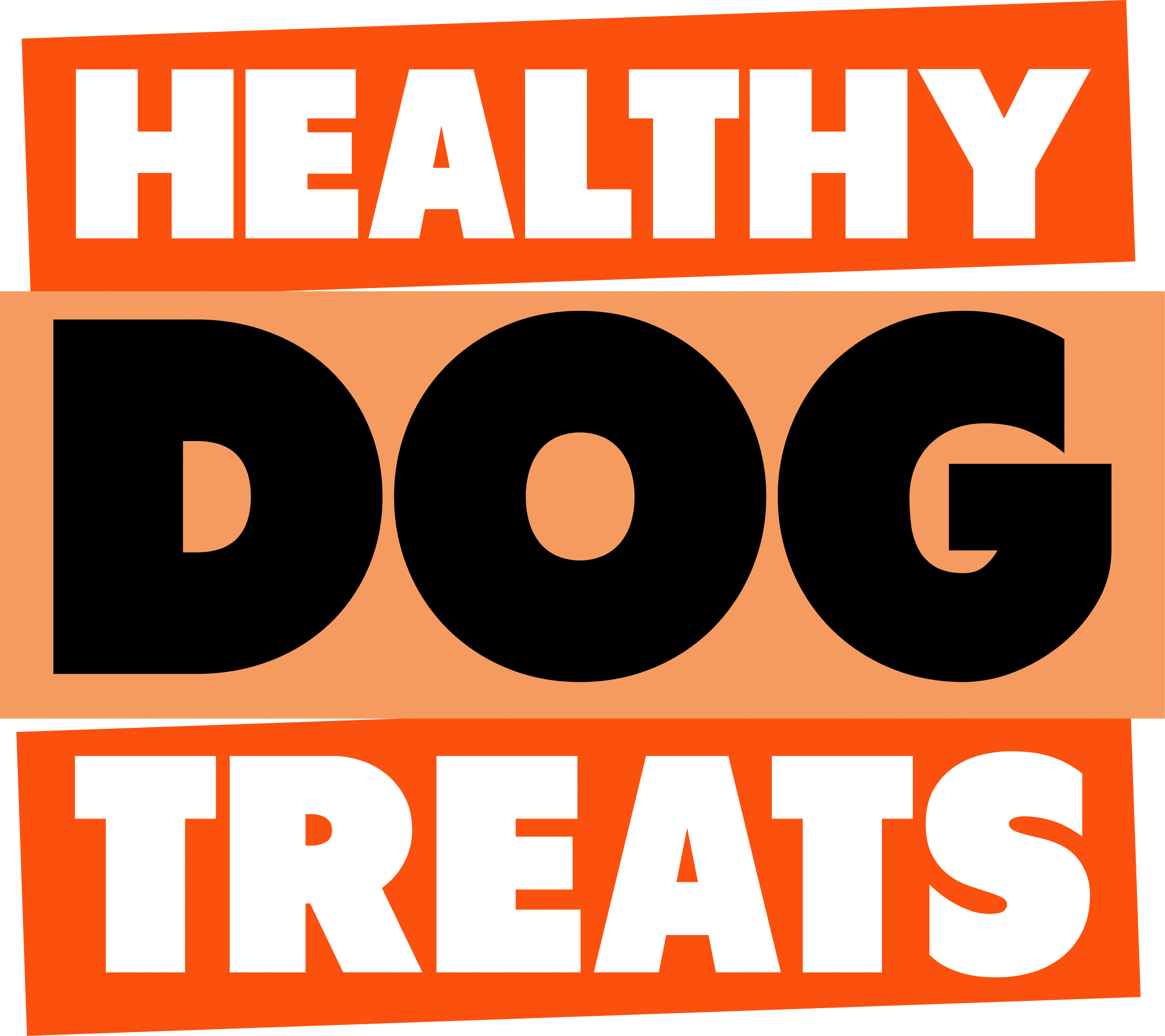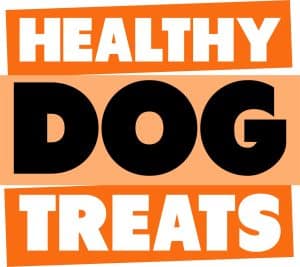No products in the cart.
Top 5 Healthy Oils your dog needs. And Why Salmon, beats Coconut, flaxseed oil etc

If you feed your dog commercial dog food, it is required to have a minimum amount of Omega 3 and Omega 6 in it. However, it doesn’t mention the source or what adding other oils to your dog’s diet will provide.
We look at the five main oils (and provide full nutrition analysis of the oil sub components – see table at end of this article) and why you should only add Salmon Fish Oil for Omega 3, and Sunflower Oil for Omega 6 needs.
We look at each oil, what the common claims and myths are, and why adding extra OTHER oils like Olive Oil and Coconut oil are unnecessary and usually wasteful.
Dog food nutrition 101.
Did you know that aafco provides minimum requirements that ALL Australian dog food must reach to be called dog food? For dogs they give values for ‘growth and reproduction” and “adult maintenance minimums” (less stringent).
If you are interested in getting the right absolute dose levels and ratio for Omega 6 to Omega 3 – we have a whole article devoted to that.
AAFCO Oil amounts required to be called dog food in Australia


So let’s instead use the ‘growth dog’ (ie puppy and pregnant dog) values of 8.5g crude fat, and 1.3% linolic acid minimum and 0.08% alpha-linoleic acid, (with Eiscosanpentaenoic + Docosahexanoic acid components ) being 0.05 %.
Many dog blogs talk about fairly inconsequential things to dog’s health like shiny coats. Yes, that is aesthetically pleasing, but not adding any health aspect to your dog specifically. Truth is, that just about any animal or vegetable oil, in sufficient quantity makes a dog coat shiny, but that isn’t a good idea to use just ANY oil.
What we are most interested in is internal dog health. For organs, brain etc.
We will go through the list of the most commonly used oils for dog’s diet, and which ones are great and not so much, as well as comparing the FULL technical information on the oil components, side by side in tabular format – you can’t get any more informed than that!
What does the aafco oil requirement for dog food mean?
Firstly, it would be extremely useful if they defined oil requirements for regular adult dogs, but they don’t, so we have to review the “Growth & Reproduction Minimum”
This should be the most important question, since most people feed their dog commercial dog food and trust it completely, and its completely based on this volunteer American table …
8.5% crude fat, means that if you feed your dog 300g of pellets, then there has to be a minimum of 3 x 8.5 grams of crude fat in it, 25.5 grams of fat from ANY source that is.
So, the only specific sub requirements for a puppy or pregnant dog are that 0.08% must be Linoleic acid and 0.05% must be (Eicosapentaenoic + Docosahexaenoic acid)
This is where the age-old question of Salmon Oil (animal source perfect for a carnivore-based species like a domestic dog, versus flax seed oil comes into focus and will be discussed further below.
Essentially linoleic Acid = OMEGA 6, and this must be at least 0.08% of the dog’s diet. If you feed your dog commercial dog food, they will sometimes use sunflower oil or another source of Omega 6 (check your ingredients) to provide this. Only a portion of any oil is Omega 3 or Omega 6 and usually not a lot of it (hence why I have produced the tech tables below for you to see exactly what is in each standard type of oil).
For 300g of dry weight dog food pellets, that means that 0.08% x 300g of Omega 6 is required which is 0.24g (or 240 ml) of Omega 3 oil. This can be achieved from quite a few sources (more on that later).
The next part of the requirement is tricker. 0.05% OMEGA 3 in the form of (Eicosapentaenoic + Docosahexaenoic acid) must be available. If you feed your dog 300g of pellets, that would mean 0.05% x 300 g = 150 mg. NOTE this is the amount of Omega 3 (not the amount of oil). If you use Salmon Oil, it is approx one third Omega 3 (the right kind).
The maximum ratio of Omega 6 to Omega 3 is 30:1. While most commercial dog foods do about 7:1 (however this is often ‘achieved on paper’ with the very inefficient flax seed). So in reality the ratio can be near the max ratio or worse.
The vital importance of Eicosapentaenoic + Docosahexaenoic acid equation (EPA and DHA) is that OMEGA 3 must be in these chemical compositions – NOT ALA
“The three main omega-3 fatty acids are alpha-linolenic acid (ALA), eicosapentaenoic acid (EPA), and docosahexaenoic acid (DHA). ALA is found mainly in plant oils such as flaxseed, soybean, and canola oils. DHA and EPA are found in fish and other seafood.” REF 5
“ALA is an essential fatty acid, meaning that your body can’t make it, so you must get it from the foods and beverages you consume. Your body can convert some ALA into EPA and then to DHA, but only in very small amounts. Therefore, getting EPA and DHA from foods (and dietary supplements if you take them) is the only practical way to increase levels of these omega-3 fatty acids in your body. “REF 4
Omega-3s are important components of the membranes that surround each cell in your body. DHA levels are especially high in retina (eye), brain, and sperm cells. Omega-3s also provide calories to give your body energy and have many functions in your heart, blood vessels, lungs, immune system, and endocrine system (the network of hormone-producing glands).“ ref 4
And this is why SALMON OIL – and OTHER ANIMAL source of OMEGA 3 (like from Healthy dog treats Kangaroo and FISH treats are so good – they provide the EPA and DHA options! (more on this later)
Noting that there are ELEVEN types of Omega 3 oil, the most important are said to be ALA, EPA and DHA, but as we will see ALA is by far the least important of these. (table of Omega 3 types at end of article).
Salmon Oil & dog treats


Noting of course that in Healthy dog treats like salmon skins, they have SOME salmon oil on them, while the tables below show the amounts of Omega 3 or Omega 6 in a 100g oil sample.
Essentially Salmon Oil is one of the BEST sources of Omega 3 in the correct form of EPA and DHA chemicals. It is easy to obtain and you have to give small amounts to correctly supplement your dog. Giving excess oil (just to get the right amount of Omega 3 or Omega 6 just adds calories (or KJ) that have to be sacrificed elsewhere.
The reason that the aafco tables give values for EPA and DHA is that EPA, helps reduce inflammation and improve kidney function while DHA is valuable for learning and vision and many other brain functions.
The reason that I am not talking about FISH OIL in general here is that some text like to suggest any fish oil, but just like land-based animals, ‘oils ARENT oils’.
Cod liver oil for instance (that we compare in the table has only about half the Omega 3 that Salmon Oil has.
I personally use Omega 3 salmon oil capsules for my dog (six each night) to work on conjunction with the Omega 6 he already gets in some of the commercial wet food I feed him. Plus, I add some sunflower Oil to ensure he gets enough Omega 6 while on his raw meat + commercial can diet.
If you want a better understanding of what Omega 3 a raw feeder needs, or why you might want to suppliant commercial dog food if it doesn’t get its Omega 3 from salmon oil – this is a detailed article I prepared earlier: What amounts and what ratio do you need in Omega 6 to Omega 3
SUNFLOWER OIL dog supplement
This is used in quite a few commercial dog foods, because its cheap and doesn’t spoil so much. It is said to provide a shiny coat and keeps their heart healthy. They say start out by giving a few drops to their kibble.
But what is it really providing to your dog? The table below shows that it gives 10.3% saturated fat. And 19% monosaturated fat (both less than Salmon Oil.
So SUNFLOWER OIL is mostly composed of polyunsaturated fats (65% compared to salmon oil 40%). Where it really shines is that it can have up to massive 65% Omega 6. Salmon provides excellent Omega 3 but very little Omega 6. BUT if you give your dog commercial dog food, they are probably getting sufficient Omega 6 already. That is, the form of Omega 6 isnt a vital as they oil used for Omega 3.
Giving Sunflower oil, is useful for many raw feeders who don’t give any or low amounts of commercial dog food,
So yes, Omega 6 is useful for “healthy dog skin and coat” and Omega 3 can act like a catalyst for Omega 6 (hence why getting Omega 3 in the right format to be used is so vital, but are their drawbacks for Sunflower oil being used as an Omega 6 source?
One article suggests “However, sunflower oil does not contain significant levels of arachidonic acid (AA or ARA), an omega-6 acid that is only found in quantity in animal fats.” REF 7
Arachidonic acid (AA, sometimes ARA) is a polyunsaturated omega-6 fatty acid 20:4(ω-6), or 20:4(5,8,11,14). It is structurally related to the saturated arachidic acid found in cupuaçu butter.
“Arachidonic acid (AA) is another omega 6 fatty acid, that is essential for cats, but not for dogs. As opposed to cats, dogs can efficiently convert LA to AA in their bodies due to an enzyme in their digestive systems. Omega 6s – “LAs are found in animal meats and plant-based oils such as corn, safflower or soybean oils “ REF 8
Therefore, AA is not considered an Essential Fatty Acid in dogs. “ REF 8
THEREFORE, Sunflower Oil is great if you need extra Omega 6 in a dogs diet. OR if you are not feeding a total commercial dog food diet, you might want to supplement some SUNFLOWER OIL Omega 6 in the right amounts
FLAX SEED OIL (= linseed oil)
This vegetable-based oil is often used in dog food, because it is cheaper and easier to prevent from spoiling HOWEVER misleadingly the table below shows Omega 3 at 53 % and Omega 6 at 12% of the oil.
Some articles say that it’s a great substitute for fish oil if your dog has a rare allergy to fish, and that it can assist with arthritis, but that is not the full story.
Flax seed oil is a “plant-based triglyceride” that contains an unusually large amount of the fatty acid ALA (Alpha-linolenic acid).
The NIH gov site says “ If the two ω-3 PUFAs present in fish (EPA and DHA) are structurally different from the ALA found in flaxseed , their effects on Cardio vascular systems may be different as well. Unfortunately, data on the impact of the ALA found in flaxseed is not as well known or as mature as the fish data, and the health-related value of ALA or flaxseed has been debated.”
A Healthline article says “ your body needs to convert the ALA in flax seeds to eicosapentaenoic acid (EPA) and docosahexaenoic acid (DHA) — a process that is often inefficient “ It’s mostly found in plant foods and needs to be converted into EPA or DHA before it can be utilized by your body for something other than energy. Ref 5
this conversion process of ALA into EPA AND DHA is inefficient in humans. On average, only 1–10% of ALA is converted into EPA and 0.5–5% into DHA ref 5
“Furthermore, the conversion rate depends on adequate levels of other nutrients, such as copper, calcium, magnesium, zinc, iron, and vitamins B6 and B7. Some omega-6 fatty acids compete for the same enzymes needed for this process. Therefore, the high amount of omega-6 in the modern diet may reduce the conversion of ALA to EPA and DHA” ref 5
Compared to DHA and EPA sourced from fish oil or algae, plant-based ALAs are less effective at reducing joint inflammation … and yes it can give a dog a shiny, coat and assist in skin issues, but because of its low conversion rate you have to use a lot more of flax seed to get the right Omega 6 to Omega 3 ratio, which adds KJ and risks them having loose stools.
As you can see having Flax seed provide the Omega 3 is VERY INEFFICIENT.
Marine based animals Sources of Omega 3
“ Both EPA and DHA are mostly found in seafood, including fatty fish and algae. For this reason, they are often called marine omega-3s. EPA concentrations are highest in herring, salmon, eel, shrimp, and sturgeon. Grass-fed animal products, such as dairy and meats, also contain some EPA. REF 5
So why is it important that your dog gets OMEGA 3 from animal (preferably its largest amount from sea animals)? A decrease in DHA in later life is also linked to impaired brain function and the onset of Alzheimer’s disease – Adequate marine Omega 3 might reduce the risk of dog dementia!
DHA may have positive effects on certain conditions, such as arthritis, high blood pressure, type 2 diabetes, and some cancers. Again, very useful for your dog!
But why does it matter if not as much flax seed ALA converts to useable ALA and DHA in your dog? Well basically because it will ruin the Omega 6 to Omega 3 ratio of seven to blow out to more like 70 plus.
Healthline says “Omega-6 fatty acids also have important roles in your body similar to those of omega-3s. Both are used to produce signaling molecules called eicosanoids, which have various roles related to inflammation and blood clotting. Yet, omega-3s are anti-inflammatory, and scientists hypothesize that eating too much omega-6 counteracts these beneficial effects.” Ref 7
Likewise, if your dog gets its Omega 3 from flax seed and the real ratio of omega 6: Omega 3 blows out to even a ratio of 20, they won’t have any anti-inflammatory effects, and can suffer arthritis, reduced brain function etc, getting the RIGHT form of OMEGA 3 is vital, and flax seed doesn’t help.
COCONUT OIL dog supplement
For the last few years this has been heralded as the best oil for dogs ever. But it’s useful knowing many of the other facts that those brands don’t tell you.
Some sources say “immune boosting, anti-inflammatory, anti-fungal, metabolism boosting,”
“While some wild claims have been debunked, coconut oil does offer the benefit of high levels of Medium Chain Triglycerides (MCTs). While limited studies have shown that several components of MCTs, such as lauric acid, capric acid, and caprylic acid offer anti-fungal, anti-viral, and antibacterial benefits for a human immune system, results are inconclusive in dogs and additional research is needed.“ ref 7
Looking at the table below you can see that Coconut oil has 86.5% saturated fat compared to Salmon oil at 19.9 %. While some people might think that is fabulous, and it will give a dog a shiny coat the only mandated aafco requirement is for total crude fat AND minimum levels of Omega 3 and Omega 6.
While Salmon oil has 35% total Omega 3 essential fatty acids, Coconut oil has ZERO.
While Salmon oil has 1.5% total Omega 6 essential fatty acids, Coconut oil has 1.8%.
And here is the the useful thing to note about “anti-fungal” properties. If your dog gets sufficient Omega 3 from Salmon Oil, after a few weeks since starting a treatment, the oil works internally first then reaches the skin to give a great protection on the skin layer.
Many long-eared dogs, and dogs like poodles or poodle mixes can have issues with feet licking and fungal growth in their ears (because the ear hangs over, closes off oxygen and light and the ear canals are a different shape than other breeds).
This makes a fungal and bacterial high population easy to occur in the ear. Likewise, if a dogs feet are itchy (because the skin between the pads is dry), they will incessantly lick it until the conditions are right for a fungal infection to occur.
But you dont need an ‘anti-fungal’ chemical to fix this. Its better to prevent the environment for fungal growth in the first place. With my dog, I noticed that only after a few weeks of Omega 3 supplementation (SALMON OIL) that my dog’s feet and ear issues that used to require cortisone treatments about 3 times a year or more when he was very young became ZERO times a year.
A properly Salmon oil (omega 3) level in your dog can prevent their skin becoming dry and cracked, so they dont want to lick their paws (adding moisture for fungus growth), and their ears natural oily barrier is maintained. With sufficient Omega 3 from Salmon Oil, you won’t probably need a specific anti-fungal treatment, or any other oil with claimed ‘anti-fungal’ properties.
NOTING that there are far better sources of Omega 6 than Salmon oil OR coconut oil, so for the primary mandated requirements in dog food OMEGA 6, Coconut oil is a fail. And noting that any extra oil that you add to a dog’s diet gives 2.5 times the KJ of protein or carbs. Meaning that you will have to reduce other vital nutrition you give to your dog if you give a substantial amount of coconut oil as a supplement.
OLIVE OIL dog supplement
Olive Oil is: 13.8% saturated fat, 73% mono saturated, 10% polyunsaturated.
Some sources say that “keeps their coats moisturized and shiny, helps with the immune systems aids cardiovascular disease and diabetes.”
This sounds great, but again this is what the other oils do, and they do it much more efficiently when they have the higher amounts of Omega 3 and Omega 6
Noting that its Olive Oil is next to useless as the prime requirement for essential fatty acids.
It only has 0.7% Omega 3 and 9.7% Omega 6. Since we are looking at preferably a ratio of 7 or lower for Omega 6 to Omega 3 ratio, we require a much higher source of Omega 6 otherwise you will have to add far too much of the oil to get a sufficiently LOW ratio, and that means too many KJ and loose stools etc.
So why not just give your dog 20 ml or olive oil anyway you might think?
OK, at 2.5 times the energy value of meat protein, that means you will have to reduce the amount of food by 50g (to equate to the 20 mL of oil energy value), if you are giving your dog 20 ml of Olive oil.
50g of meat dog treats will have up to the equivalent of 30g of protein. Since many dog foods give the bare amount of minimum protein (18%) to save of the cost of meat, you could either supplement your dog with meat dog treats (50g) and give them an extra 30g or protein … OR you can give them olive oil that has very low values of Omega 3 or Omega 6 in them.
Why would you do that, if the Omega3 and Omega 6 you give them (Salmon Oil or Sunflower oil supplements) are already giving them their required levels at relatively low extra Kilo Joules?
COD LIVER OIL dog supplements
Being a fish oil, this seems promising to most dog owners.
It has a similar amount of saturated fats as Salmon oil and a very large amount of mono unsaturated fats 46%. But since Essential fatty acids (EFAs) are polyunsaturated fats, and it only has 22% of these the resulting Omega 3 is only 20% and Omega 6 around 1%.
Being one of the higher Omega 3 sources might suggest that this could be a substitute for Salmon oil, but not so.
Besides the positive effects of the EFA, fats are also vital for your dog to absorb vitamins such as Vitamin A, D, E and K.
Besides cod liver having lower levels of Omega 3 (even though it’s the right type), it has much higher levels of Vitamin A and D.
Aafco give MAXIUM amounts of vitamins: Vitamin A 250000 IU/ Kg and Vitamin D 3000 IU/ Kg. Excessive vitamin A and D can cause organ damage. Thus in order to give the smallest amount of oil (to keep KJ down) while giving sufficient proper form Omega 3, and not giving too much Vitamin A and D can be quite a difficult balancing act.
The best source of Omega 6
While we prefer animal-based or marine-based oils, and meat has Omega 6 in it, if you are adding supplements you may end up referring to tables such as in Canine and Feline Nutrition (case et al).
They suggest the best sources of Omega 6 are from: Corn oil (70%), Safflower oil 78%, Sunflower Oil (69%), Cottonseed oil (54%), Soybean oil (54%).
I personally have been using Sunflower oil for Omega 6 along with Salmon Oil for Omega 3 for many years. Preference is given to Sunflower oil for Omega 6, because of its high Omega 6 value, availably and low cost. If it is true that Arachidonic acid is not an essential Omega 6 form for dogs, then sunflower oil is probably still the preferred option among these omega 6 sources.
Noting that the conversion of each Essential fatty acid (EFA) is as follows:
N 3 (omega 3) series – alpha lionenic – Stearidonic > Eicosatetraenoic > Eicosapentaenic (EPA) > 3 and 5 series eiconosanoids (less inflammatory)
N 6 series (omega 6) series: linoleic > gamma- linolenic > dihomo-gamma-linolenic > arachidonic > 2 and 4 series eciconoids (inflammatory) (ref 5)
CONCLUSIONS
There are many oils on the market that many random blogs claim have amazing properties for dogs.
If you trust your dog food to deliver a whole and complete balanced diet, you wouldn’t be using any extra oils at all.
From the above information you can see that Salmon Oil (omega 3) should be a supplement used by everyone who isn’t getting their Omega 3 via an animal source in their regular dog food.
If you mostly feed a commercial dog food diet, it probably has enough Omega 6 in the right formulation that you don’t need to supplement it that much.
Ensuring a ratio of close to 7:1 Omega 6 to Omega 3 is useful, for very skin allergy prone dogs an effective ratio as low as 4:1 is thought to be better.
We don’t recommend using a lot of excess oil in your dog’s diet, unless it is required to make up for shortfalls (such as caused by using flax seed) etc. Excess oil can lead to loose stools and poor nutrient uptake.
If you use kangaroo or fish based single ingredient dog treats you can get a PROTEIN boost and Omega 3 supplement that natural way …
Negative effects of TOO MUCH OIL
“Too much of any oil can cause weight gain, says Dr. Scanlan. “A large dose of oil all at once can cause pancreatic issues in a susceptible individual—especially if they are fat,” she adds. Too much oil can also lead to a vitamin E deficiency if you don’t properly supplement with some additional vitamin E. Fish oil can prolong the time it takes blood to clot, so if your pet is going to have surgery, it’s best to stop the oil for at least five days before and five days after the operation, Dr. Scanlan says. (petmd)“
Picking the right source of oil for your dog (REF 8)
“Omega 6s stimulate hormones that promote inflammation in your dog’s body. Omega 3’s balance this by producing hormones that reduce inflammation and regulate the immune system. If your dog consumes too much omega 6 without enough omega 3, this can lead to a state of chronic inflammation in a dog’s body. This may lead to diseases such as cardiovascular disease, cancers, arthritis, bowel diseases, skin conditions and a general imbalance in their immune system.
“Grains such as corn and soy have higher omega 6: omega 3 levels that grass and leafy vegetation. This translates to meat from grain-eating livestock having a higher omega 6: omega 3 ratio than the meat from grass-fed livestock.” For example, grain-fed beef typically has an omega 6: omega 3 ratio of 5:1 – 10:1, while grass-fed beef has a ratio of 1:1 – 3:1.
The ELEVEN forms of OMEGA 3
ALA, EPA, and DHA are the most abundant omega-3 fatty acids in your diet. (healthline)
However, at least eight other omega-3 fatty acids have been discovered:
- hexadecatrienoic acid (HTA)
- stearidonic acid (SDA)
- eicosatrienoic acid (ETE)
- eicosatetraenoic acid (ETA)
- heneicosapentaenoic acid (HPA)
- docosapentaenoic acid (DPA)
- tetracosapentaenoic acid
- tetracosahexaenoic acid
+++
5 TOP Oils CHEMICAL COMPOSITION – as used for DOGS
| Salmon Oil | Coconut Oil | Flaxseed oil | Sunflower Oil | Olive Oil | Cod Liver Oil | |
| Total fat | 100g | 100g | 100g | 100g | 100g | 100g |
| Saturated fat | 19.9 | 86.5 | 9.4 | 10.3 | 13.8 | 22.6 |
| 4:00 | ||||||
| 6:00 | 0.6 | |||||
| 8:00 | 7.5 | |||||
| 10:00 | 5.999 | |||||
| 12:00 | 44.6 | |||||
| 14:00 | 3.28 | 16.8 | 3.567 | |||
| 16:00 | 9.839 | 8.2 | 5.3 | 5.9 | 11.289 | 10.631 |
| 17:00 | 0.022 | |||||
| 18:00 | 4.245 | 2.8 | 4.1 | 4.5 | 1.953 | 2.799 |
| 20:00 | 0.414 | |||||
| 22:00 | 0.129 | |||||
| 24:00:00 | ||||||
| Monounsaturated Fat | 29 | 5.8 | 20.2 | 19.5 | 73 | 46.7 |
| 14:01 | ||||||
| 15:01 | ||||||
| 16:1 undifferentiated | 4.824 | 1.255 | 8.309 | |||
| 16:1 C | ||||||
| 16:1 t | ||||||
| 17:01 | 0.125 | |||||
| 18:1 undiferentiated | 16.976 | 5.8 | 20.198 | 19.503 | 71.265 | 20.65 |
| 18:1 c | ||||||
| 18:1 t | ||||||
| 20:01 | 0.311 | 10.421 | ||||
| 22:1 undiferentiated | 7.328 | |||||
| 22:1 c | ||||||
| 22:1 t | ||||||
| 24.1 c | ||||||
| Polyunsaturated Fat | 40.3 | 1.8 | 66 | 65.7 | 10.5 | 22.5 |
| 16:2 undifferentiated | – | |||||
| 18:2 undifferentiated | 1.0543 | 1.8 | 12.701 | 65.702 | 9.763 | 0.935 |
| 18:2 n-6 c,c | ||||||
| 18:2 c,t | ||||||
| 18:2 t,c | ||||||
| 18:2 t,t | ||||||
| 18:2 i | ||||||
| 18:2 t not further defined | ||||||
| 18:03 | 53.304 | 0.761 | 0.935 | |||
| 18:3 n-3, c,c,c | ||||||
| 18:3 n-6, c,c,c | ||||||
| etc (NO VALUES) | ||||||
| Salmon Oil | Coconut Oil | Flaxseed oil | Sunflower Oil | Olive Oil | Cod Liver Oil | |
| Total trans fatty acids | ||||||
| Total trans-monoenoic fatty acid | ||||||
| Total trans-polyenoic fatty acids | ||||||
| Total Omega-3 fatty acids | 35.311 | ZERO | 53.304 (ALA FORM) | ZERO | 0.761 | 19.736 |
| Total Omega-6 fatty acids | 1.543 | 1.8 | 12.701 | 65.702 | 9.763 | 0.935 |
REFERENCES
REF 1 = AAFCO METHODS FOR SUBSTANTIATING NUTRITIONAL ADEQUACY OF DOG AND CAT FOODS
ref 4 – Omega-3 Fatty Acids
ods.od.nih .gov
Ref 5 The 3 Most Important Types of Omega-3 Fatty Acids
Healthline .com/nutrition
REF 7 ADDING HEALTHFUL OILS TO A DOG’S DIET REGIMEN
nomnomnow .com
ref 8 Everything you need to know about Essential Fatty Acids for your dog
journal.lyka .com.au


